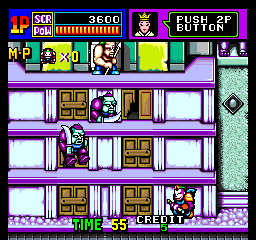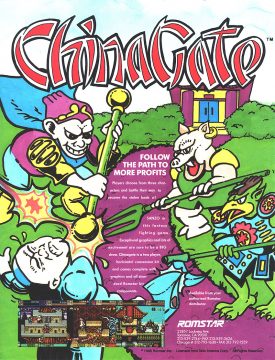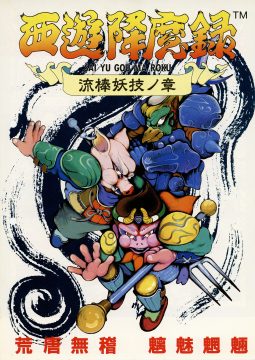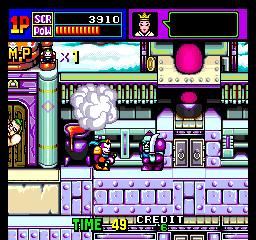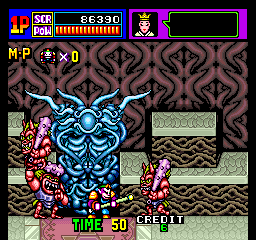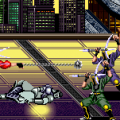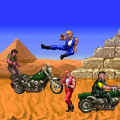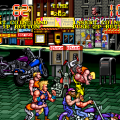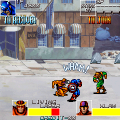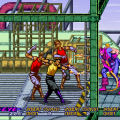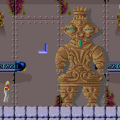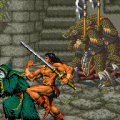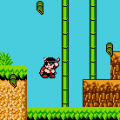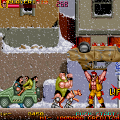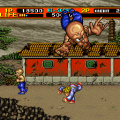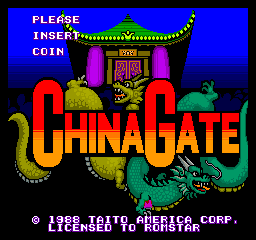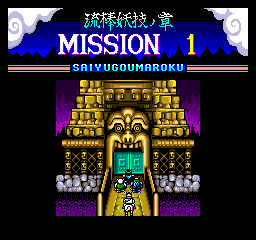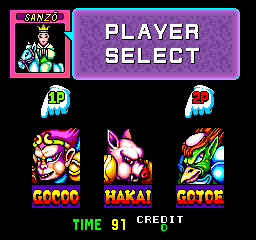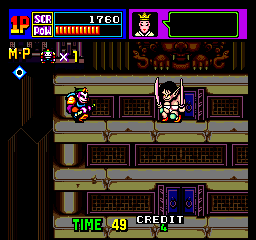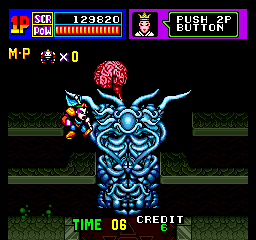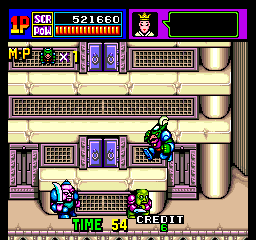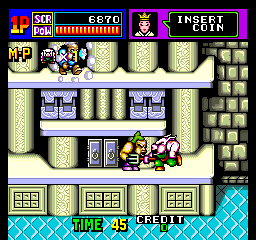This game is featured in our Arcade Cult Classics book, which is filled with other unique and obscure arcade games!
Technos created the foundations of the beat-em-up genre with the Kunio-kun and Double Dragon games, but before those series really took off, they released the arcade-only China Gate. The Japanese title is Saiyuu Goumaroku: Ryuubouyougi no Shou (“Journey to the West Exorcism Record: Chapter of Flowing Stick Magic”).
Taking on the role of Gocoo (Son Goku) the monkey king, Hakai (Cho Hakkai) the pig, and Gojoe (Sa Gojo) the kappa, each of the game’s five stages takes place in a tower, several stories high. (Sanzo is shown on the top of the character select screen, but isn’t actually playable.) There are three buttons here — attack, jump, and a special magic technique, which are obtained in limited quantities by defeated enemies. All three characters share the same basic movement, but employ their own unique weapons. Even though it doesn’t use an isometric perspective as in belt-scrolling games like Double Dragon, it unquestionably plays like a beat‑em-up, right down to the hit stuns and combo attacks.
In addition to a standard combo, you can also hold a direction to jab an enemy with your weapon and fling them over your shoulder, knocking down any foe from the other side. You can also execute spinning moves by jumping and holding Up while attacking, or jumping attacks by holding downwards and attacking in the air. These jumping attacks prove to be some of the most useful, as they’re tough for enemies to counterattack, even if they don’t do a whole lot of damage. Opponents attack with their own weapons too, including axes and flaming arrows.
Defeated enemies can also drop two types of magic spell orbs, weak and strong. This is where the characters differ, as each has their own unique magic spells. Gocoo unleashes a mini duplicate of himself in his weak attack, while shooting out four-way projectiles for his strong spell; Hakai can toss fireballs or summon enormous weights to drop on enemies; and Gojoe has an electric ball as well as a lightning attack.
Even though each stage has a tower, you actually don’t need to climb it at all. In fact, you can stay on the bottom floor until you’ve disposed of enough enemies for the boss to arrive. You can use the floors to your advantage however, dropping above or below foes to avoid their attacks and then surprise them from behind. Proper positioning is quite important! While you can scale up or down by jumping, if you’re knocked off of a high floor, you’ll automatically ride onto a floating cloud and can fly to any point on the screen, and without any additional life penalty. This is certainly a welcome technique, as it lets you reposition yourself easily.
You’ll need to use every option at your disposal too, as China Gate is pretty tough, even in two-player simultaneous mode. The basic enemies on the first two stages aren’t too bad, but the bosses prove to be quite troublesome. Directly attacking them leaves you open to counters, so you’ll need to figure out their patterns and weak spots to keep them at bay. This is particularly tough on the third boss, Ravana, based on the multi-armed Hindu god, who will electrocute you upon making contact and shoots lightning bolts whenever you’re far away. An even harder variation, Neo Ravana, appears as the final boss, and this iteration even shoots out his arms. It also refuses to die, as its brain will emerge from its decapitated head to torment you one last time before you’re able to see the ending.
Outside of the bosses, the enemies attack more ferociously in the later stages too, and it can become exhausting. That’s one of the biggest issues with China Gate — since you’re fighting in arenas rather than proper levels, it never feels like you’re really advancing, even though the backgrounds technically do change. It just gets harder and harder, until eventually your stamina (or your wallet) wears out, or you finally make it to the end.
The game still has an appeal to it though, one that marks it as a distinctly Technos game. All of the sprites are rendered as diminutive, squat figures, similar to the Bikkuriman stickers that were popular in Japan at the time. The difference here is that instead of cute characters, everyone looks like ugly demons, even the heroes.
Despite the added verticality found here, it still feels remarkably like Double Dragon, right down to the sound effects. Even the enemies look pretty similar to some of the bad guys, despite their shrunken stature. It also has some cool touches though, like the way that the weak foes scramble off of the screen in panic when the arena turns dark and lightning strikes, heralding the arrival of the boss.
China Gate was never ported anywhere, as Technos clearly found more success with their other beat-em-up properties, especially in the international scene. Its cabinet, however, can be spotted in a few scenes in the 1989 movie The Wizard. Still, it’s interesting since it predates many genre conventions, and thereby is free to play by its own rules. Pluss, since it never received any sequels, or even any games similar to it, this makes for a brawling experience unlike anything else.
Links
IGCC Retrospective in Japanese
